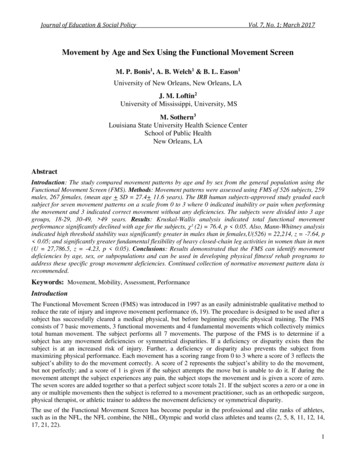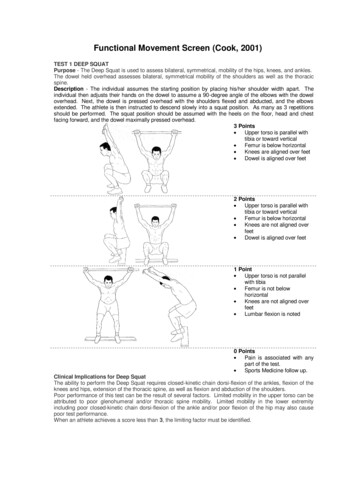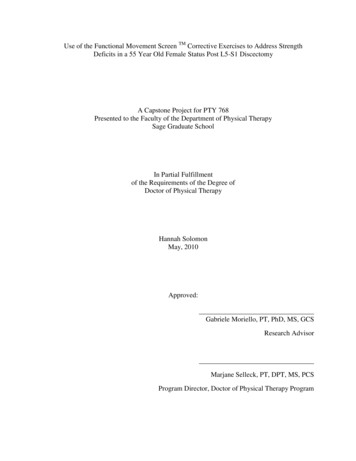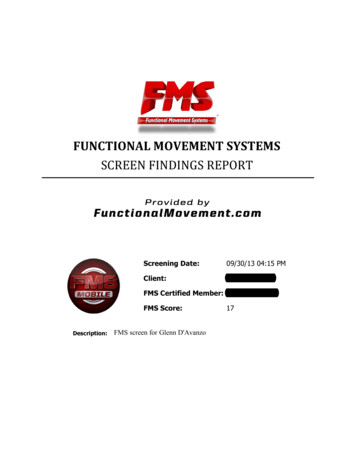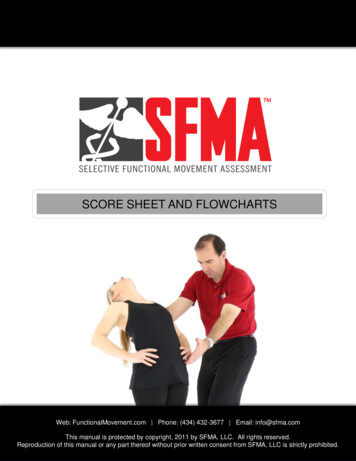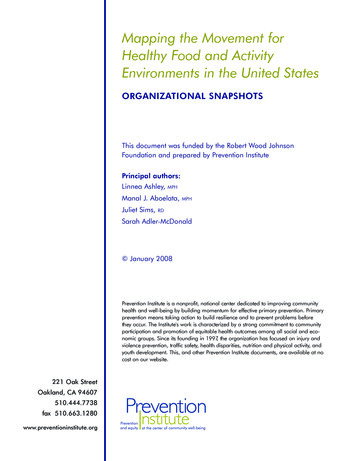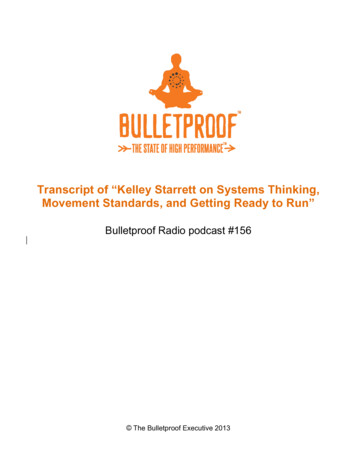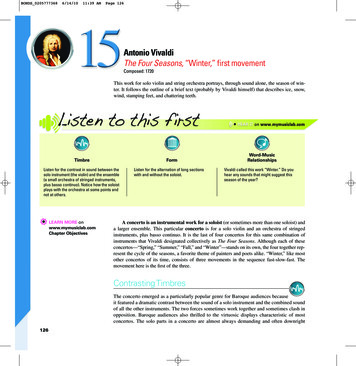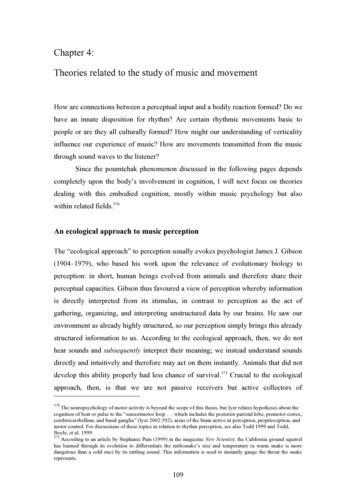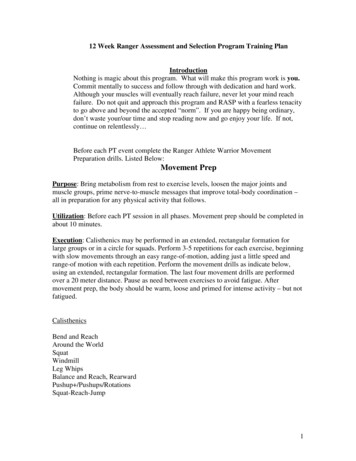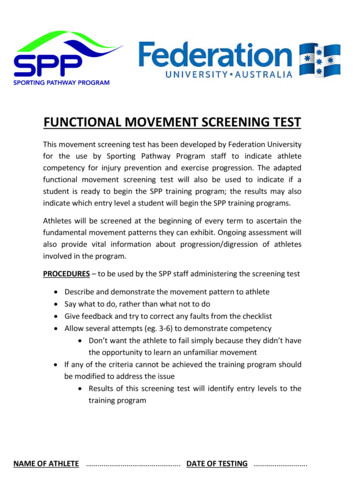
Transcription
FUNCTIONAL MOVEMENT SCREENING TESTThis movement screening test has been developed by Federation Universityfor the use by Sporting Pathway Program staff to indicate athletecompetency for injury prevention and exercise progression. The adaptedfunctional movement screening test will also be used to indicate if astudent is ready to begin the SPP training program; the results may alsoindicate which entry level a student will begin the SPP training programs.Athletes will be screened at the beginning of every term to ascertain thefundamental movement patterns they can exhibit. Ongoing assessment willalso provide vital information about progression/digression of athletesinvolved in the program.PROCEDURES – to be used by the SPP staff administering the screening testDescribe and demonstrate the movement pattern to athleteSay what to do, rather than what not to doGive feedback and try to correct any faults from the checklistAllow several attempts (eg. 3-6) to demonstrate competency Don’t want the athlete to fail simply because they didn’t havethe opportunity to learn an unfamiliar movement If any of the criteria cannot be achieved the training program shouldbe modified to address the issue Results of this screening test will identify entry levels to thetraining program NAME OF ATHLETE . DATE OF TESTING .
PARALLEL SQUAT With a shoulder width stance squat until the top of the thighs are parallel to the floorArms held straight and forwardCharacteristics to look for:CompetentNotes/comments for the athleteMaintain of neutral spineKeeping the feet flat on the floorAvoid excessive forward leanKnees in line with feetExample of good parallel squatting technique
STANDING LONG JUMP Jump forward from two legs to land on two feet – jump with about 80% max effortThis test is not about distance travelled but more so about the landing‘Stick’ the landing by maintaining balance and control for at least one secondCharacteristics to look for:CompetentNotes/comments for the athleteMaintain of neutral spineKeep the landing soft by dropping to ahalf squat position (approx.) on landingAvoid excessive forward leanKnees in line with feet – nowobble/valgus on landingMaintain balance on landing for aminimum one second with no wobbleExample of jumping technique
WALKING LUNGE With arms by side – perform four consecutive lunges (two on each leg – alternating leg)Back knee just off the floorSupport on the ball of the back footCharacteristics to look for:CompetentNotes/comments for the athleteMaintain of neutral spineFront foot – keep the heel on the floorAvoid excessive forward leanKnee over the toe in line with feet – nowobble of front leg or valgusHips level (no dropping of hip on back legside)Maintain balanceExample of walking lunges (with light weight)
SINGLE LEG HALF SQUAT (LEFT AND RIGHT) Squat to a 90 degree angle at the knee – 2-5 repsArms held straight and forwardFree leg can be straight in front or bent at the kneeCharacteristics to look for:Maintain of neutral spineKeep the feet flat on the floor – supportlegAvoid excessive forward leanKnees in line with feet – nowobble/valgusHips level (no dropping of hip on free legside)Maintain balanceCompetentLRLRLRLRLRLRNotes/comments for the athlete
JUMP TO SINGLE LEG LANDING (LEFT AND RIGHT) Jump from two foot stance to land on one leg – aim for about 80% of max effort when jumping‘Stick’ the landing by maintaining balance and control for at least one secondCharacteristics to look for:CompetentLMaintain of neutral spineRLKeep the landing soft by dropping to ahalf squat position (approx.)RKeep the heel on the floor of landing footLRLAvoid excessive forward leanRLKnees in line with feet – nowobble/valgusRHips level (no dropping of the hip on freeleg side)Maintain balanceNotes/comments for the athleteLRLRExample of good/bad landing technique
ZIG ZAG BOUNDING FOR DISTANCE AND CONTROL Mark out 5m long parallel lines – 50cm apartBalancing on the right leg – bound onto the left foot to clear the left line without touching it thenimmediately rebound to land on the right foot to land over the right line‘Stick’ the landing by maintaining balance and control on right foot for at least one secondRepeat starting on left legOnly measure the distance if there was no loss of balance on the final landing – distance is measuredfrom the toe at the start to the toe on the final landing footCharacteristics to look for:Maintain of neutral spineKeep the final landing soft by dropping toa half squat position (approx.)Avoid excessive forward leanKnees in line with feet – nowobble/valgusHips level (no dropping of hip on free legside)Maintain balanceCompetentRLRLRLRLRLRLNotes/comments for the athlete
ACTIVE KNEE EXTENSION Ensure shoulders remain on groundEnsure other leg remains on groundMaintain 90 degree angle at hipPartner can support the extended legCharacteristics to look for:Right leg hamstring resultLeft leg hamstring resultResultNotes/comments for the athlete
SINGLE LEG CALF RAISE Single leg stance using wall for minimal supportPerform as many single leg calf raises as possibleCould use a metronome to set cadence (60 reps/min is most common cadence)Test ends when;o Athlete cannot achieve maximal ankle extensiono Leans heavily on wall and uses wall for assistance25-30 repetitions is typically used as a targetCharacteristics to look for:ResultNotes/comments for the athleteRight leg resultLeft leg resultCalf raise using stick to support – will be using the wall to support in this testMust fully extend the ankle – to be counted as a rep
PRONE/PLANK HOLD Athlete assumes the prone hold (see below) position on their elbowsAthlete is instructed to statically hold the position for as long as possibleTest ends when;o Athlete becomes fatigued and voluntarily stopso Fails to maintain proper postureo Wriggles sideways/forwardso Moves feet or arm positionSee below for table of percentilesCharacteristics to look for:Prone positionResultNotes/comments for the athlete
functional movement screening test will also be used to indicate if a student is ready to begin the SPP training program; the results may also indicate which entry level a student will begin the SPP training programs. Athletes will be screened at the beginning of every term to ascertain the fundamental movement patterns they can exhibit. Ongoing assessment will also provide vital information .
